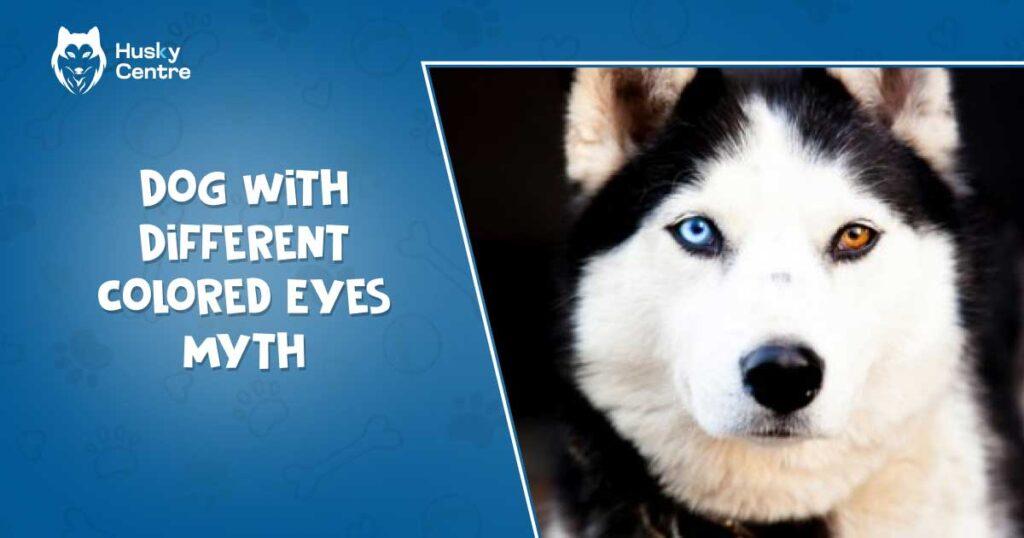Dogs with different colored eyes, known as heterochromia, are not mythical but a real genetic trait. This condition is generally harmless.
Heterochromia in dogs, where each eye is a different color, often sparks curiosity and wonder. This unique trait can be found in several breeds, including Huskies, Border Collies, and Australian Shepherds. While some people might associate these striking eyes with myths or superstitions, the reality is quite simple.
Heterochromia results from variations in the distribution of melanin, the pigment responsible for eye color. It can occur due to genetics or occasionally due to an injury. Most dogs with heterochromia lead healthy, normal lives without any vision problems. Embracing this trait as a fascinating aspect of canine diversity helps debunk any myths surrounding it.
Common Myths About Dogs With Different Colored Eyes
Dogs with different colored eyes, often due to a condition known as heterochromia, have fascinated people for centuries. This unique trait has given rise to a variety of dog eye color myths. Here, we’ll delve into the common myths about dogs with different colored eyes, separating fact from fiction.
Beliefs About Luck
Some cultures believe that dogs with different colored eyes bring good luck. These myths about dog eye color are often rooted in folklore. People think these dogs can see both heaven and earth, acting as guardians.
- Good Luck Charms: In some cultures, these dogs are considered good omens. People think they bring prosperity and happiness to households.
- Guardians of Spirits: Another belief is that these dogs can ward off evil spirits. Their unique eyes supposedly scare away bad energies.
Not everyone shares these beliefs. Some think dogs with different colored eyes are bad luck. These contrasting views highlight the diverse beliefs about heterochromia in dogs.
| Culture | Belief |
| Japanese | Good luck, can see spirits |
| Western | Mixed views, some think good luck, others bad luck |
Vision Issues
A common myth is that dogs with different colored eyes have vision problems. Many believe these dogs can’t see well. This is not true.
Heterochromia in dogs usually doesn’t affect their vision. Their eyes function normally despite the color difference.
- No Vision Impairment: Most dogs with heterochromia have perfect vision. The color difference doesn’t impact their sight.
- Health Checks: It’s always good to have regular vet checks. This ensures the dog’s eyes are healthy and functioning well.
While some eye conditions can affect vision, heterochromia isn’t one of them. This myth persists due to a lack of awareness.
Supernatural Abilities
Another interesting myth is that dogs with different colored eyes have supernatural abilities. People believe these dogs possess special powers.
Some think these dogs can communicate with spirits. Others believe they have heightened senses.
- Spiritual Guides: In some cultures, these dogs are seen as guides for the afterlife. Their unique eyes are thought to give them spiritual insight.
- Heightened Senses: Another belief is that these dogs can sense danger better. Their different colored eyes are seen as a sign of this ability.
These beliefs are fascinating, but they have no scientific basis. Dogs with different colored eyes are just like any other dogs in terms of abilities.
Why These Myths Persist And How They Vary Across Cultures
Dog superstitions and myths about dog eye color persist for several reasons. Cultural traditions play a big role. Stories and beliefs pass down through generations.
In some cultures, these myths are more prominent. For example, in Japan, dogs with different colored eyes are seen as mystical. In Western cultures, the views are mixed.
- Folklore: Many myths come from ancient folklore. These stories often contain elements of magic and mystery.
- Lack of Awareness: People may not know the scientific reasons for heterochromia. This leads to the spread of myths.
Overall, these myths add an element of intrigue to these unique dogs. Understanding the reality behind heterochromia can help dispel these myths.
The Science Behind Different Colored Eyes In Dogs
Dogs with different colored eyes often capture our attention and spark curiosity. Known as heterochromia, this phenomenon is both fascinating and mysterious. In this blog post, we explore the myths and realities behind dogs with different colored eyes. Let’s dive into the science behind different colored eyes in dogs.
Heterochromia
Heterochromia refers to the presence of different colored eyes in a single individual. This condition occurs due to variations in the distribution and concentration of melanin, the pigment responsible for eye color. In dogs, heterochromia can be classified into three main types:
- Complete Heterochromia: Each eye is a different color entirely. For example, one eye may be blue while the other is brown.
- Sectoral Heterochromia: A single eye contains two different colors. For example, a blue segment within a brown eye.
- Central Heterochromia: The inner ring of the iris is a different color than the outer ring.
Heterochromia in animals, including dogs, is primarily a genetic trait. Mutations affecting melanin distribution play a significant role. Sometimes, heterochromia may result from injury, disease, or medications. Understanding dog eye color genetics helps explain why some dogs have this unique trait.
How Common Heterochromia Is In Dogs
Heterochromia is relatively uncommon in dogs. Estimates suggest it affects less than 1% of all dogs. Despite its rarity, certain factors can increase the likelihood:
- Genetic Predisposition: Some breeds have a higher genetic predisposition for heterochromia.
- Coat Color: Dogs with merle or piebald coat patterns often have a higher incidence of heterochromia.
According to studies, heterochromia is more frequently observed in specific breeds. While it is a striking feature, it usually does not impact the dog’s health or vision. Regular veterinary check-ups ensure any underlying issues are addressed.
Which Breeds Are More Likely To Have It
Certain dog breeds are more likely to exhibit heterochromia due to their genetic traits. These breeds include:
| Breed | Likelihood of Heterochromia |
| Siberian Husky | High |
| Australian Shepherd | Moderate |
| Border Collie | Moderate |
| Great Dane | High |
| Chihuahua | Low |
These breeds have genetic traits that make them more susceptible to heterochromia. For instance, Siberian Huskies and Australian Shepherds often have merle or piebald coat patterns. Such patterns are linked to variations in melanin, leading to different eye colors. Understanding the reasons for dog eye color differences can enhance our appreciation for these unique animals.
Is Heterochromia A Health Concern For Dogs?
Dogs with different colored eyes, known as heterochromia, often spark curiosity and wonder. Many pet owners ask, “Is heterochromia a health concern for dogs?” Understanding the myths and realities behind this unique trait can help you care better for your furry friend.
Heterochromia Doesn’t Affect A Dog’s Health Or Vision
Dog heterochromia concerns are common, but the condition is typically harmless. Heterochromia doesn’t affect a dog’s health or vision. It’s just a cosmetic difference. Dogs with this trait can see clearly, run, and play like any other dog.
Here are some key points to understand:
- Genetic Trait: Heterochromia is often inherited. It’s more common in certain breeds like Huskies and Australian Shepherds.
- No Pain: Dogs with different colored eyes don’t experience any pain or discomfort due to their eye color.
- Normal Vision: Their vision remains normal. Heterochromia doesn’t cause blindness or vision loss.
Many dog owners worry about dog eye health due to heterochromia. This worry is mostly unfounded. Dogs with heterochromia are as healthy as those with matching eye colors. Here’s a quick comparison to put your mind at ease:
| Aspect | Heterochromia | Normal Eyes |
| Health Impact | No impact | No impact |
| Vision | Normal vision | Normal vision |
| Comfort | No discomfort | No discomfort |
Signs Of Potential Eye Health Issues
While heterochromia itself is harmless, eye health in dogs is crucial. Look out for signs that might indicate issues beyond heterochromia. Vision concerns in dogs can arise from various conditions. Early detection is key.
Watch for these signs:
- Redness or swelling: Could indicate infections or injuries.
- Excessive tearing or discharge: May suggest allergies or blocked tear ducts.
- Cloudiness: Can be a symptom of cataracts or other vision impairments.
- Frequent pawing at the eyes: Often a sign of irritation or pain.
Keep an eye on these symptoms. They could indicate underlying problems. Regular vet check-ups are vital. Your vet can provide a thorough examination and guide you on dog eye health.
If you notice any of the above signs, consult your vet immediately. Proper care and timely intervention can prevent serious issues. Maintaining good eye health in dogs ensures they live a happy, healthy life.
Frequently Asked Questions
What Causes Dogs To Have Different Colored Eyes?
Dogs have different colored eyes due to a condition called heterochromia. It occurs due to a difference in melanin levels in each eye. This condition can be genetic or caused by an injury or illness.
Is Heterochromia In Dogs Harmful?
Heterochromia in dogs is generally harmless. It mainly affects the appearance of the eyes. However, it’s always good to consult a vet to rule out underlying health issues.
Are Certain Dog Breeds More Prone To Heterochromia?
Yes, certain breeds are more prone to heterochromia. Breeds like Huskies, Australian Shepherds, and Dalmatians commonly exhibit this trait. Genetic factors play a significant role in its occurrence.
Can Heterochromia Affect A Dog’s Vision?
Heterochromia does not typically affect a dog’s vision. It mainly changes the eye color. However, if the condition is due to an injury or illness, vision might be impacted.
Conclusion
Myths about dogs with different colored eyes often overshadow the facts. These unique eye colors are mostly harmless. They add to the dog’s charm and do not affect its health. Understanding the reality helps in appreciating these beautiful animals better.
Embrace the diversity in your furry friends.


Meet Jarred, the heart and soul behind HukyCentre. With a deep affection for furry friends, he pours his passion into every word he writes. His genuine love for dogs shines through in his engaging and informative content. As a dedicated dog enthusiast, Jarred’s goal is to share valuable insights and tips that resonate with fellow dog lovers. Join Jarred on the journey as he celebrates the joy and companionship that dogs bring into our lives.



